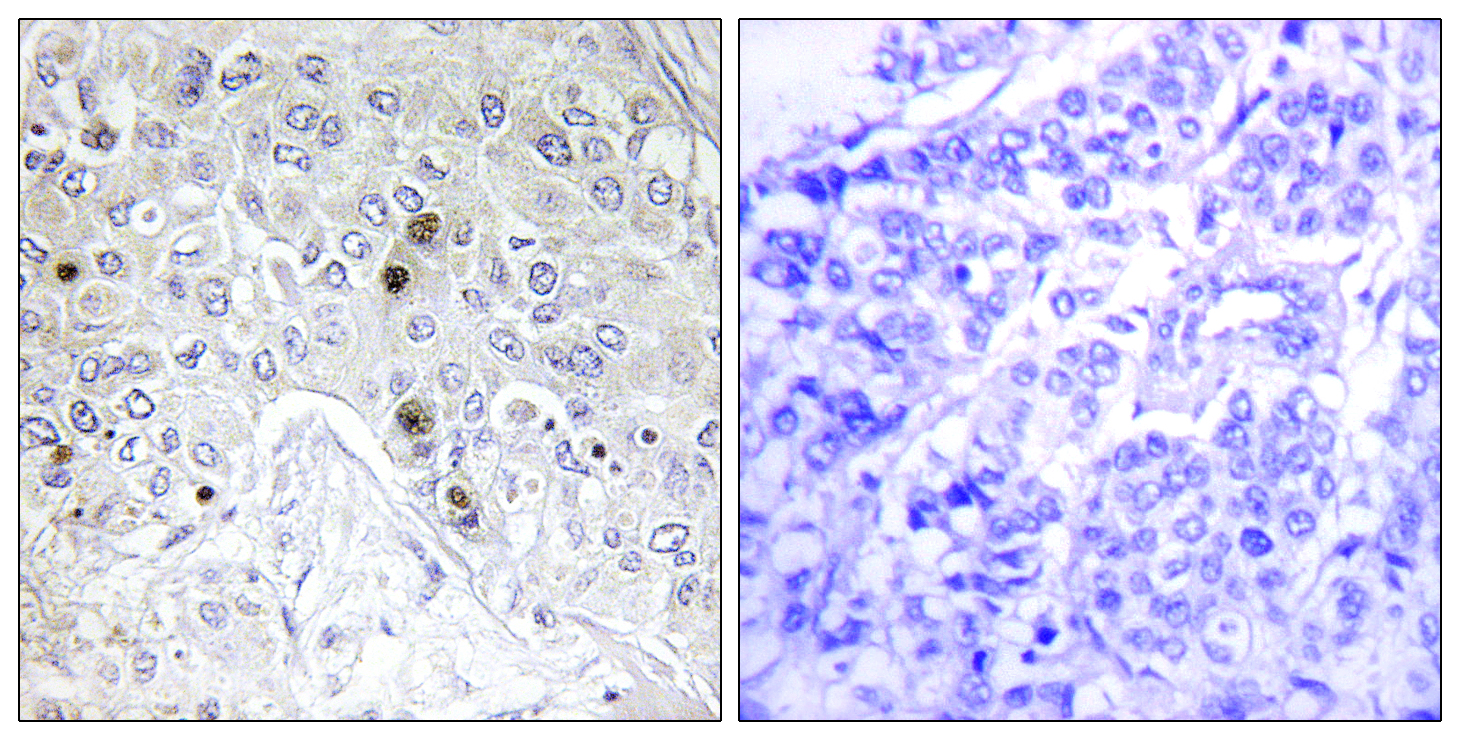B-ATF Polyclonal Antibody
- Catalog No.:YT0454
- Applications:IHC;IF;ELISA
- Reactivity:Human;Mouse
- Target:
- B-ATF
- Fields:
- >>PD-L1 expression and PD-1 checkpoint pathway in cancer
- Gene Name:
- BATF
- Protein Name:
- Basic leucine zipper transcriptional factor ATF-like
- Human Gene Id:
- 10538
- Human Swiss Prot No:
- Q16520
- Mouse Gene Id:
- 53314
- Mouse Swiss Prot No:
- O35284
- Immunogen:
- The antiserum was produced against synthesized peptide derived from human BATF. AA range:10-59
- Specificity:
- B-ATF Polyclonal Antibody detects endogenous levels of B-ATF protein.
- Formulation:
- Liquid in PBS containing 50% glycerol, 0.5% BSA and 0.02% sodium azide.
- Source:
- Polyclonal, Rabbit,IgG
- Dilution:
- IHC 1:100 - 1:300. ELISA: 1:5000.. IF 1:50-200
- Purification:
- The antibody was affinity-purified from rabbit antiserum by affinity-chromatography using epitope-specific immunogen.
- Concentration:
- 1 mg/ml
- Storage Stability:
- -15°C to -25°C/1 year(Do not lower than -25°C)
- Other Name:
- BATF;Basic leucine zipper transcriptional factor ATF-like;B-cell-activating transcription factor;B-ATF;SF-HT-activated gene 2 protein;SFA-2
- Molecular Weight(Da):
- 14kD
- Background:
- The protein encoded by this gene is a nuclear basic leucine zipper protein that belongs to the AP-1/ATF superfamily of transcription factors. The leucine zipper of this protein mediates dimerization with members of the Jun family of proteins. This protein is thought to be a negative regulator of AP-1/ATF transcriptional events. [provided by RefSeq, Jul 2008],
- Function:
- function:Functions as a negative regulator of AP-1 mediated transcription by binding to Jun proteins. Jun/B-ATF heterodimers bind DNA preferentially at the 12-O-tetradecanoylphorbol-13-acetate response element (TRE) (consensus: 5'-TGA[CG]TCA-3') and weaker at the cAMP-responsive region (CRE) (consensus: 5'-GTGACGT[AC][AG]-3'), but are transcriptionally inert.,PTM:Phosphorylated.,similarity:Belongs to the bZIP family.,similarity:Contains 1 bZIP domain.,subunit:Forms heterodimers with JUN, JUNB and JUND. Also interacts with IFI35.,tissue specificity:Expressed at highest levels in lung, and at lower levels in placenta, liver, kidney, spleen, and peripheral blood. Detected in SW480 colorectal cancer cell line and several hematopoietic tumor cell lines, including Raji Burkitt's lymphoma. Strongly expressed in mature B- and T-lymphocytes. According to PubMed:10777209 also expressed in moderate
- Subcellular Location:
- Nucleus . Cytoplasm . Present in the nucleus and cytoplasm, but shows increased nuclear translocation after activation of T-cells. .
- Expression:
- Expressed at highest levels in lung, and at lower levels in placenta, liver, kidney, spleen, and peripheral blood. Detected in SW480 colorectal cancer cell line and several hematopoietic tumor cell lines, including Raji Burkitt's lymphoma. Strongly expressed in mature B- and T-lymphocytes. Also expressed in moderate levels in lymph node and appendix and at low levels in thymus and bone marrow (PubMed:10777209).
- June 19-2018
- WESTERN IMMUNOBLOTTING PROTOCOL
- June 19-2018
- IMMUNOHISTOCHEMISTRY-PARAFFIN PROTOCOL
- June 19-2018
- IMMUNOFLUORESCENCE PROTOCOL
- September 08-2020
- FLOW-CYTOMEYRT-PROTOCOL
- May 20-2022
- Cell-Based ELISA│解您多样本WB检测之困扰
- July 13-2018
- CELL-BASED-ELISA-PROTOCOL-FOR-ACETYL-PROTEIN
- July 13-2018
- CELL-BASED-ELISA-PROTOCOL-FOR-PHOSPHO-PROTEIN
- July 13-2018
- Antibody-FAQs
- Products Images

- Immunohistochemical analysis of paraffin-embedded Human breast cancer. Antibody was diluted at 1:100(4° overnight). High-pressure and temperature Tris-EDTA,pH8.0 was used for antigen retrieval. Negetive contrl (right) obtaned from antibody was pre-absorbed by immunogen peptide.

- Immunohistochemistry analysis of paraffin-embedded human breast carcinoma tissue, using BATF Antibody. The picture on the right is blocked with the synthesized peptide.



